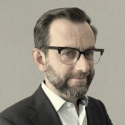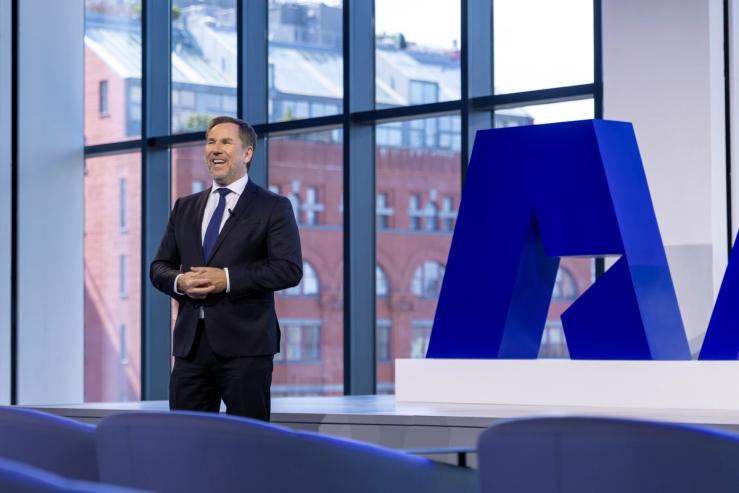The Scene
Jan Jenisch became CEO of LafargeHolcim in 2017, after the world’s largest cement company had been shaken by an internal probe of its Syria operations and culture clashes stemming from the €41bn Franco-Swiss merger that created it. He stepped down last year after a widely praised turnaround, but returns in a new role on Monday, launching Holcim’s transformed North American business on the New York Stock Exchange, with an estimated $30 billion valuation.
The spinoff, branded Amrize (short for “ambition” and “rising”), is the region’s largest cement business and second biggest commercial roofing provider, but Jenisch is pitching it as something more: a fast-growing provider of “solutions” and builders’ partner of choice on high-profile projects such as Apple’s Cupertino headquarters.
Jenisch, who will be Amrize’s chairman and CEO, says companies often spin off their least attractive assets, but this is not the case for Zurich-listed Holcim. Amrize is eyeing 8% to 11% annual earnings growth over the next three years — driven in part by acquisitions in an industry that remains fragmented, even as rivals such as Saint-Gobain and Owens Corning chase similar opportunities.
This interview has been condensed and edited for clarity.
The View From Jan Jenisch
Andrew Edgecliffe-Johnson: You’ve articulated the case for why it makes sense for Holcim to spin off its North American business. Why does the market need an independent Amrize?
Jan Jenisch: The North American business is just too successful to be a subsidiary of Holcim. In the last four years we have doubled the company’s revenues from $6 billion to $12 billion and, more importantly, we have a $200 billion addressable market. So we want to do everything to focus Amrize on the growth opportunities in North America. There are plenty: both organic investments, but also further M&A. We believe being independent, being focused — with a US board, US leadership, US investor relations, reporting in US GAAP, being at the New York Stock Exchange — will help us to further accelerate.
You’re clearly ambitious for more M&A. How did you apportion debt between the two businesses to give yourself that flexibility?
We’ve basically given both companies the same leverage, because both companies have a lot of opportunities to invest. And then Amrize has very high cash flow generation. Last year, we did $1.7 billion in cash flow, and this will continue. When I did my investor road show, I think every investor asked, “So you have a lot of cash, what are you going to do?” And the [answer] is easy: We’re going to invest. We have a pipeline of projects, and we want to accelerate M&A. And in case we don’t have enough ideas to execute, we will return the money to the shareholders.
In the last six years, we have done 130 M&A transactions — more than 20 a year. And we have done this massive transformation, increased margin and cash flow at the same time and halved the debt leverage. So we have been, I would say, smart in doing M&A, and we want to keep it this way. We want to spend a lot of money on M&A, but we need good deals.
In a spinoff, the initial shareholders are your existing Holcim shareholders. They know the assets. But over time, we can expect that to change and new US investors to come in. What do you think is your primary challenge in telling this story to the US market?
In the past, when I represented Holcim, maybe 25 to 30% of the shareholders were North American, but they were mostly global funds. Now [we have] all the funds focusing on US-listed, dollar denominated, GAAP reporting companies. So I expect we’ll have a huge inflow of US investors. Also, my opinion is that the market we are in — in infrastructure, commercial building, and residential housing — is super attractive, super big and super growing. And there are not many public companies in the space, so I believe we are really going to be a hot stock.
We have organized the company to be ‘local for local,’ so every product we sell in North America, we produce in North America. Think about this: We have a $12 billion business and we have no tariffs on any of our products at the moment, because we literally produce locally. So this is a very strong position. No one has a $12 billion business like this.
The 2015 merger of Holcim and Lafarge was widely viewed in the market as having fallen into a trap that many mergers of equals fall into. What do you consider were the most important moves you took to turn things around?
Discipline, speed, and execution are key. When I came in in 2017, I went to 30 markets, and I had two basic findings. First of all, [we had] very strong local businesses, from supply chain to the people. So the positioning was really good. [But] the corporate departments were just lost. They were just overlooked, overloaded with resources and [had] no clear direction. They had four corporate offices — one in Paris, one in Switzerland, one in Singapore, one in Miami. I closed all four, and I made it clear that our future is not in the headquarters; it’s in the markets.
I had a big office in Paris, a bigger one in Switzerland. We went to a very modest site, and I gave myself an office of 16 square meters, just to demonstrate to the people that this company is not based on status. Then four years ago, I was visiting Michael Bloomberg in New York, and I realized he has no office, so I have had no office for the last four years, and that’s a good thing. We don’t have a headquarters culture. We’re going to have about 150 people in Chicago. And that’s it, out of 19,000. We go around to all the markets and make sure we are aligned with the people on the ground and the customers.


